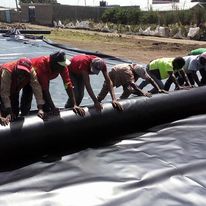Landfills have evolved significantly over the past few decades, integrating advanced technologies to manage waste more efficiently and reduce environmental impact. One of the critical components in modern landfill design is the synthetic liner. This blog post explores what synthetic liners are, their benefits, and their role in sustainable landfill management.
What is a Synthetic Liner?
A synthetic liner is a layer made from synthetic materials such as high-density polyethylene (HDPE), linear low-density polyethylene (LLDPE), or polyvinyl chloride (PVC). These materials are chosen for their durability, flexibility, and resistance to chemical degradation, making them ideal for containing and isolating waste materials in landfills.
Benefits of Using Synthetic Liners
- Leak Prevention: Synthetic liners act as a barrier to prevent leachate, the liquid that drains from a landfill, from seeping into the soil and groundwater. This helps in protecting local water sources from contamination.
- Durability: These liners are designed to withstand the harsh conditions within a landfill, including heavy loads, chemical exposure, and temperature variations.
- Flexibility: Synthetic liners can be customized and installed to fit the specific contours and requirements of a landfill site, ensuring complete coverage and protection.
- Regulatory Compliance: Using synthetic liners helps landfill operators meet stringent environmental regulations, ensuring safer waste management practices.
Types of Synthetic Liners
- HDPE Liners: Known for their high tensile strength and resistance to chemicals and UV radiation, HDPE liners are commonly used in hazardous waste landfills.
- LLDPE Liners: These liners offer greater flexibility than HDPE liners, making them suitable for applications where the landfill contours are more complex.
- PVC Liners: While less commonly used due to their lower chemical resistance compared to HDPE and LLDPE, PVC liners are still employed in certain landfill applications due to their flexibility and ease of installation.
Installation and Maintenance
Proper installation and maintenance of synthetic liners are crucial for their effectiveness. The installation process involves:
- Site Preparation: Ensuring the landfill base is smooth and free from sharp objects that could puncture the liner.
- Liner Deployment: Unrolling and placing the liner carefully to avoid wrinkles and overlaps.
- Sealing and Testing: Welding the seams and conducting tests to ensure there are no leaks or weak points.
Regular inspections and maintenance are necessary to address any damage or wear over time. This includes repairing punctures, reinforcing weak spots, and replacing sections of the liner if needed.
Environmental and Economic Impact
Using synthetic liners in landfills has both environmental and economic benefits. By preventing leachate contamination, synthetic liners help protect ecosystems and public health. Economically, they can reduce the long-term costs associated with environmental cleanup and liability.
Future Trends
Advancements in materials science are leading to the development of even more robust and sustainable synthetic liners. Innovations such as geomembranes with enhanced chemical resistance and biodegradable liners are on the horizon, promising further improvements in landfill management.
Conclusion
Synthetic liners play a pivotal role in modern landfill management, offering a reliable solution for waste containment and environmental protection. As technology advances, we can expect even more effective and sustainable liners to emerge, further enhancing landfill safety and efficiency.
For more information on synthetic liners and landfill management, check out these resources:
By understanding and implementing the best practices in landfill management, we can contribute to a cleaner and safer environment for future generations.
Originally posted 2024-12-11 15:58:00.

